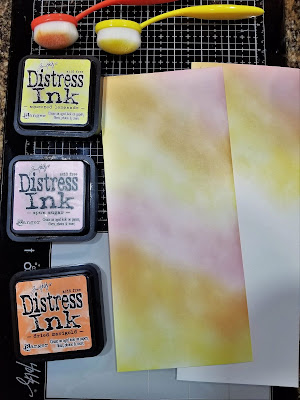Welcome back to Magenta Super Saturday and thank you for visiting my blog today.
This time I used alcohol inks instead of Nuance. (I think you could also mix some Nuance powders with a small amount of water to make the colors very concentrated, then use them in the same way I used the alcohol inks.) You can also see my card on the Magenta blog here.
I sprayed the shaving cream onto a disposable baking sheet, then added drops of Sunset Orange, Sunset Yellow, Valencia and Terra Cotta alcohol inks. I used a palette knife to mix the colors a bit then gently laid the Sweet Leaves stencil on the top of the shaving cream.
I placed a piece of 80# Neenah white cardstock on top of the stencil then gently pushed both pieces down into the shaving cream - I wanted to be sure the cream came in contact with all the open spots on the stencil. The paper absorbs the color very quickly. I slowly lifted both the paper and stencil from the shaving cream and laid them on my work surface. I gently lifted the stencil from the paper, used a straight edged tool to remove the shaving cream from the card stock, then wiped the cardstock with a dry towel to remove any remaining shaving cream. (If there are any areas that don’t have shaving cream on them when you lift the paper and stencil from the shaving cream, just use your palette knife to scoop up some cream and place it on the empty spot. Let it sit for a bit then remove all the shaving cream.)
It took me a few tries to come up with the process I liked. I realized that the most vibrant colors came from the first use of the shaving cream after the ink had been applied. Although you can re-use the shaving cream many, many times, the colors start blending and the colors get softer and lighter. I also discovered that I wanted some color in my background. On the final piece for today I blended some Scattered Straw and Dried Marigold Distress ink over the cardstock, let it dry, then proceeded with the shaving cream process.
After my pieces were dry, I decided I wanted to emphasize the leaves just a little bit more. I lined up the stencil over the leaves then used a dauber brush to apply Distress Abandoned Coral around the edges of the leaves.
On another piece, I put one of the stenciled pieces back into the shaving cream after the colors had lightened and blended some. This also gave an interesting result.
I stamped the sentiment onto a piece of white cardstock with VersaFine Sepia ink and embossed with clear embossing powder. I used a bit of Scattered Straw and Dried Marigold Distress ink around the edges of the sentiment. I matted the card front and sentiment on pieces of reddish-brown cardstock. After the card was assembled, I added a few sequins for a bit of sparkle.
Thanks for visiting my blog today.
Magenta Products Used
 |
| 07.970.G - All you Need is Love |
 |
| TM320 - Sweet Leaves |
Other Products Used
Ranger Alcohol Inks (Sunset Orange, Sunset Yellow, Valencia, Terra Cotta)
Distress Inks (Scattered Straw, Abandoned Coral, Dried Marigold)
VersaFine Ink (Sepia)
Judikins Clear Embossing Powder
I-Crafter I-Brush Ink Applicator Brushes
Barbasol Shaving Cream





















